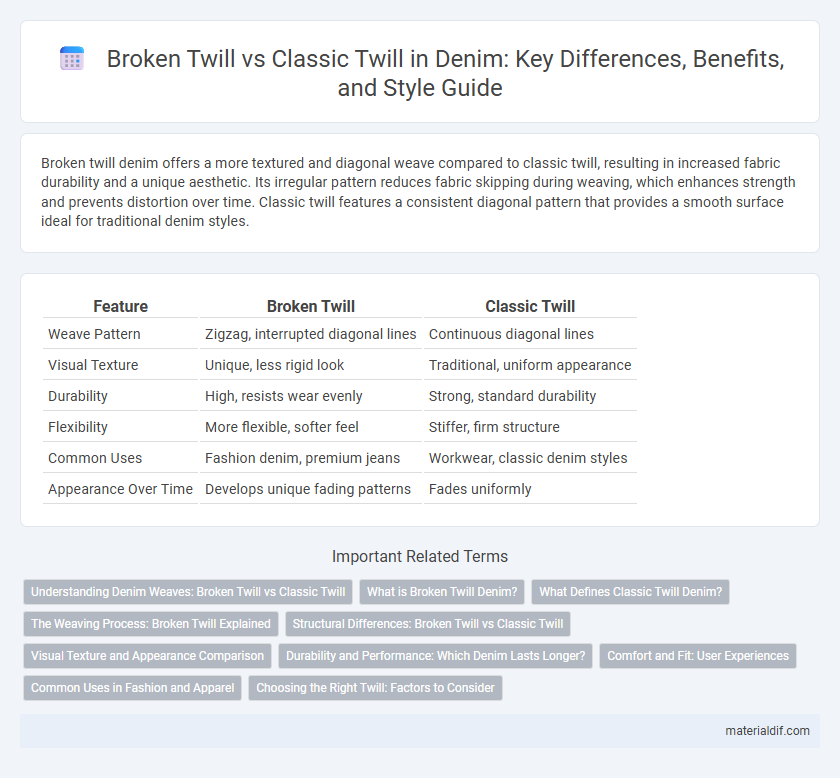Broken twill denim offers a more textured and diagonal weave compared to classic twill, resulting in increased fabric durability and a unique aesthetic. Its irregular pattern reduces fabric skipping during weaving, which enhances strength and prevents distortion over time. Classic twill features a consistent diagonal pattern that provides a smooth surface ideal for traditional denim styles.
Table of Comparison
| Feature | Broken Twill | Classic Twill |
|---|---|---|
| Weave Pattern | Zigzag, interrupted diagonal lines | Continuous diagonal lines |
| Visual Texture | Unique, less rigid look | Traditional, uniform appearance |
| Durability | High, resists wear evenly | Strong, standard durability |
| Flexibility | More flexible, softer feel | Stiffer, firm structure |
| Common Uses | Fashion denim, premium jeans | Workwear, classic denim styles |
| Appearance Over Time | Develops unique fading patterns | Fades uniformly |
Understanding Denim Weaves: Broken Twill vs Classic Twill
Broken twill denim features an interrupted weave pattern that reduces the diagonal lines found in classic twill, creating a more subtle texture and enhancing fabric durability. Classic twill denim is characterized by a distinct diagonal ribbing formed by tightly woven yarns, which provides strength and a pronounced directional appearance. The choice between broken twill and classic twill impacts the fabric's wrinkle resistance, visual complexity, and overall comfort in denim garments.
What is Broken Twill Denim?
Broken twill denim features a distinctive diagonal weave pattern that alternates direction, creating a zigzag effect that reduces vertical wear lines commonly seen in classic twill denim. This weaving technique enhances durability and softness, resulting in a fabric that resists fading and creasing more effectively than traditional right-hand or left-hand twills. Popular in premium denim brands, broken twill offers a unique aesthetic and improved comfort without sacrificing strength.
What Defines Classic Twill Denim?
Classic twill denim is defined by its diagonal weave pattern, created by the weft thread passing under two or more warp threads, resulting in a sturdy and durable fabric. This traditional weave offers a smooth surface on the front with a softer, textured backside, contributing to denim's characteristic strength and comfort. The consistent diagonal ribbing distinguishes classic twill from broken twill, where the pattern is interrupted, giving a more irregular and unique texture.
The Weaving Process: Broken Twill Explained
Broken twill denim features a unique weaving process that alternates the direction of diagonal lines, creating a zigzag or broken pattern on the fabric surface. This technique softens the fabric and reduces the likelihood of visible wear lines compared to classic twill, which has a consistent diagonal weave. The weaving process of broken twill enhances durability and adds visual texture, making it a preferred choice for high-quality denim production.
Structural Differences: Broken Twill vs Classic Twill
Broken twill denim features an irregular zigzag pattern created by alternating the direction of the twill weave, enhancing fabric softness and reducing diagonal lines visible on the surface. Classic twill denim maintains a uniform diagonal weave that produces a smooth, consistent texture with pronounced diagonal ridges. The structural difference results in broken twill offering improved breathability and flexibility, while classic twill provides traditional durability and a distinctive twill appearance.
Visual Texture and Appearance Comparison
Broken twill denim features a zigzag pattern created by alternating the direction of the twill weave, resulting in a more textured and visually irregular surface compared to classic twill's consistent diagonal lines. This distinct visual texture enhances the fabric's depth and dimension, making broken twill appear more dynamic and less uniform. Classic twill provides a smoother, more traditional look with clear, parallel diagonal ridges that emphasize uniformity and subtlety in its appearance.
Durability and Performance: Which Denim Lasts Longer?
Broken twill denim features a distinctive weave pattern that enhances fabric strength by distributing stress more evenly, resulting in improved durability compared to classic twill. Classic twill denim, with its diagonal rib pattern, offers a traditional look and moderate durability but tends to wear out faster in high-friction areas. Therefore, broken twill denim generally outperforms classic twill in longevity and resistance to wear, making it the preferred choice for long-lasting denim garments.
Comfort and Fit: User Experiences
Broken twill denim offers enhanced comfort and fit due to its unique diagonal weave, which increases fabric flexibility and reduces stiffness compared to classic twill. Users report that broken twill jeans conform more naturally to body movements, providing a snug yet breathable experience. Classic twill denim, with its tighter weave, tends to feel more rigid initially but often softens significantly after multiple washes.
Common Uses in Fashion and Apparel
Broken twill denim features a zigzag weave that reduces the traditional diagonal pattern, offering enhanced durability and a softer texture, making it ideal for casual wear and fashion-forward jeans. Classic twill denim, characterized by its distinct diagonal ribs, maintains a firm structure favored in workwear and traditional denim styles. Both weaves cater to different apparel needs, with broken twill popular in trendy, comfortable clothing and classic twill prevalent in rugged, long-lasting garments.
Choosing the Right Twill: Factors to Consider
Choosing the right twill for denim depends on factors like texture, durability, and appearance. Broken twill offers a distinctive diagonal weave with less visible lines, resulting in a softer hand feel and reduced diagonal fading, while classic twill showcases a sharper, more defined diagonal pattern with stronger durability. Consider the intended garment style, desired fade pattern, and comfort level to select between broken twill and classic twill denim options.
Broken twill vs classic twill Infographic

 materialdif.com
materialdif.com